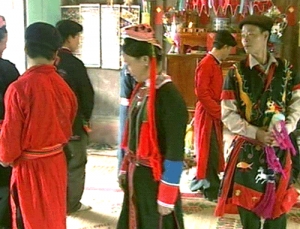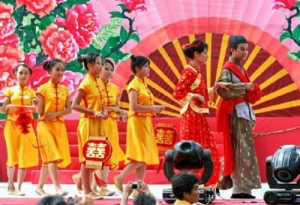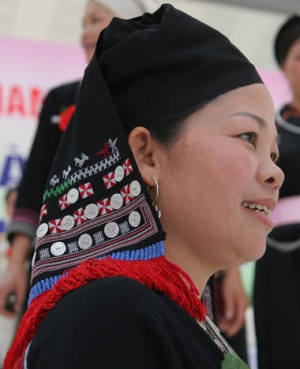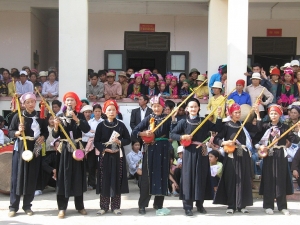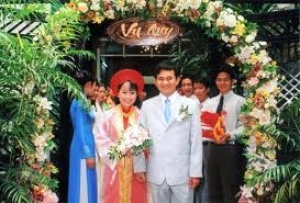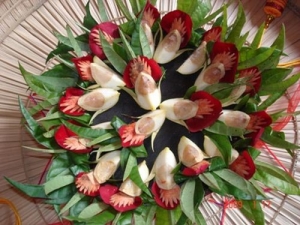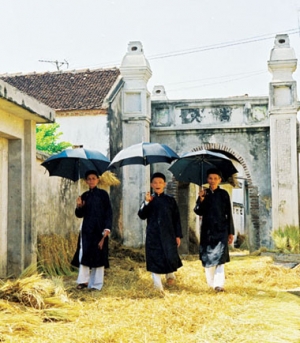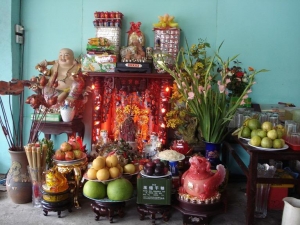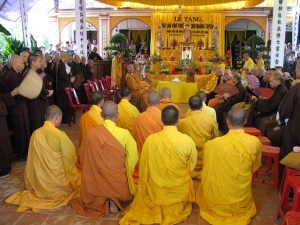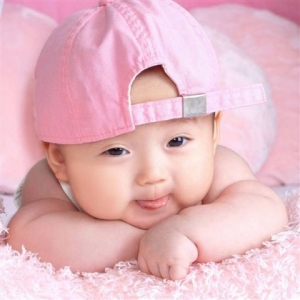
Asia Pacific Travel Team
Dao in Quang Ninh
Their dwellings are either earthen houses or mixed (half earthen, half on stilts). The Dao believe that in all creatures there are souls called hon or vân. When a living creature dies.
Name: Dao (Thanh Y, Thanh Phán)
Region: Occupying the highlands
Customs and habits: Their dwellings are either earthen houses or mixed (half earthen, half on stilts). The Dao believe that in all creatures there are souls called hon or vân. When a living creature dies, its soul separates from the body and becomes a phantom. They believe the world is occupied by these wandering souls, and practice the cult of ancestors to honour them.
Language: Mông-Dao
Culture: The popular literature and arts of ethnic groups are also extremely distinct. There are many unique legends, poems and songs, with themes ranging from nature to familial and social relationships which is expressed by "Two Sisters" "Catching Sprite" stories. Rich and attractive dances include the Dance of the Bells and Drum Dance; musical instruments: Drum, Gong, Bell.
Traditional clothing: long robes, trousers, large belts, turbans and leggings. Clothes are usually black or deep blue.
Economy: and their means of survival is essentially agriculture. Today, a few households have turned to forestry, wet rice growing or domestic animal breeding.
Hoa in Quang Ninh
Name: Hoa (Hán)
Region: Towns: Cẩm Phả, Uông Bí, Móng Cái; Districts: Đầm Hà, Hải Hà, Đông Triều.
Customs and habits: The Hoa build houses with three compartments and two lean-tos and live close together. Families of a same lineage always reside together. In a Hoa family, the husband is the head of the household and the right to inherit is reserved for the sons. The eldest son always gets the greater part of the property.
In all villages and hamlets, there are temples, pagodas, and shrines built for worshipping. Parents plan marriage arrangements for their children, and early marriages are common. The choice of a husband or a wife is often based on the desires of the family to have equal social standing or is dictated by business considerations. Funerals must go through several rituals.
Language: The Hoa language belongs to the Hán language group.
Culture: The Hoa loves singing “son ca”, musical plays. They have many musical instruments such as horns, clarinets, drums, flutes, cymbals, castanets, Chinese four-chord lute, and zither...
Traditional clothing: Hoa men wear clothing. Hoa women wear trousers, five-panelled vests, and short-sleeve shirts.
Economy: The Hoa practise various occupations including agriculture, handicrafts, trading, fishing, and salt making. Hoa farmers have a long tradition of cultivating submerged fields. They also work as labourers, teachers, and cadres.
Nung in Quang Ninh
Name: Nùng.
Region: Uông Bí Town, Tiên Yên and Ba Chẽ districts.
Customs and habits: The Nùng mainly worship their ancestors, spirits, saints, Confucius, and Kwan Yin. Nùng villages are often built on hillsides.
Language: The Nùng language resembles the Tày belongs Tày -Thái language.
Culture: The Nùng have abundant folk arts and cultural activities including folk songs and alternative songs. The smooth melodies of Sli songs are harmonious with the natural sounds of the forests and mountains. This type of folk song is a combination of verse and music. The “Lông Tông Ceremony” (Going to the Fields) is very well known and attracts many people of all ages. This ceremony is always organised during the first month of the lunar year.
Traditional clothing: The Nùng mainly wear indigo attire.
Economy: The Nùng live mainly on rice and corn. They also grow fruit trees such as tangerines and persimmons, and anise.
Tay in Quang Ninh
Name: Tày
Region: Towns: Cẩm Phả, Uông Bí; Districts: Hải Hà, Ðông Triểu, Ba Chẽ, Vân Ðồn, Hoành Bồ
Customs and habits: They live in villages and hamlets, either along stream shores or in plains and valleys. Houses were formerly built on stilts, but today modern changes can be seen in construction. For the Tày, the most characteristic practice is also the cult of ancestors, with the most important duties belonging to the “family-chief”
Language: Tày - Nùng
Culture: The popular literature and arts of ethnic groups are also extremely distinct. There are many unique legends, poems and songs, with themes ranging from nature to familial and social relationships which is expressed by "Nùng Trí Cao" "Nàng Khuây", "Pú Luông - Già Cai" stories; Musical instrument: Tính.
Traditional clothing: the Tày wear short jackets, long robes, skirts, trousers, belts, turbans, cloth shoes and jewellery. These are mainly of a black or deep blue colour.
Economy: Their main means of living are agriculture and animal breeding.
Wedding Ceremony
Getting married is an important event in a Vietnamese’s life. The procedure of the ancient wedding ceremony was very complicated. Current wedding ceremony procedures include the following steps: the search for a husband or wife, the proposal, the registration, and finally the wedding.
Depending on habits of specific ethnic groups, marriage includes various steps and related procedures, but generally there are two main ceremonies:
 Le an hoi (betrothal ceremony): Some time before the wedding, the groom and his family visit the bride and her family with round lacquered boxes known as betrothal presents composed of gifts of areca nuts and betel leaves, tea, cake, fruits, wines and other delicacies covered with red cloth and carried by unmarried girls or boys. Both families agree to pick a good day for wedding.
Le an hoi (betrothal ceremony): Some time before the wedding, the groom and his family visit the bride and her family with round lacquered boxes known as betrothal presents composed of gifts of areca nuts and betel leaves, tea, cake, fruits, wines and other delicacies covered with red cloth and carried by unmarried girls or boys. Both families agree to pick a good day for wedding.
 Le cuoi (wedding ceremony): Guests would be invited to come to join a party and celebrate the couple’s happiness. The couple should pray before the altar asking their ancestors for permission for their marriage, then to express their gratitude to both groom’s and bride’s parents for raising and protecting them. Guests will share their joy at a party later
Le cuoi (wedding ceremony): Guests would be invited to come to join a party and celebrate the couple’s happiness. The couple should pray before the altar asking their ancestors for permission for their marriage, then to express their gratitude to both groom’s and bride’s parents for raising and protecting them. Guests will share their joy at a party later
Customs of Chewing Betel and Areca Nuts and smoking thuoc lao
According to legends, chewing quid of betel and areca has been a custom since the Hung Vuong period and is connected to the antique legend of betel and areca.
 A quid of betel, also called trau, is composed of four elements: an areca leaf (sweet taste), betel bark (hot taste), a chay root (bitter taste), and hydrated lime (pungent taste). The custom of chewing betel nut is unique to Vietnam. Old health books claim that "chewing betel and areca nut makes the mouth fragrant, decreases bad tempers, and makes digesting food easy". A quid of betel makes people become closer and more openhearted. At any wedding ceremony, there must be a dish of betel and areca nut, which people can share as they enjoy the special occasion.
A quid of betel, also called trau, is composed of four elements: an areca leaf (sweet taste), betel bark (hot taste), a chay root (bitter taste), and hydrated lime (pungent taste). The custom of chewing betel nut is unique to Vietnam. Old health books claim that "chewing betel and areca nut makes the mouth fragrant, decreases bad tempers, and makes digesting food easy". A quid of betel makes people become closer and more openhearted. At any wedding ceremony, there must be a dish of betel and areca nut, which people can share as they enjoy the special occasion.
During festivals or Tet Holidays, betel and areca nut is used for inviting visitors and making ac quaintances. Sharing a quid of betel with an old friend is like expressing gratitude for the relationship. A quid of betel and areca nut makes people feel warm on cold winters days, and during funerals it relieves sadness. Betel and areca nuts are also used in offerings. When Vietnamese people worship their ancestors, betel and areca nut must be present at the altar. Nowadays, the custom of chewing betel remains popular in some Vietnamese villages and among the old.
quaintances. Sharing a quid of betel with an old friend is like expressing gratitude for the relationship. A quid of betel and areca nut makes people feel warm on cold winters days, and during funerals it relieves sadness. Betel and areca nuts are also used in offerings. When Vietnamese people worship their ancestors, betel and areca nut must be present at the altar. Nowadays, the custom of chewing betel remains popular in some Vietnamese villages and among the old.
Let’s not forget to mention thuoc lao or strong tobacco. For women, betel can initiate various feminine conversation, but for men, thuoc lao is related to their joyfulness as well as the sadness in their lives.
Peasants always carry their dieu cay (pipe for smoking while ploughing the rice fields)
Villages – Guilds
The Vietnamese culture has always evolved on the basis of the wet rice civilization. Thus, the lifestyle of the Vietnamese population is closely related to its village and native lands.
 In Vietnamese society, people gather together to form villages in rural areas, and guilds in urban areas. Villages and guilds have been forming since the dawn of the nation. These organizations have gradually developed for the population to be more stable and closer together. Each village and guild has its own regulations called conventions.
In Vietnamese society, people gather together to form villages in rural areas, and guilds in urban areas. Villages and guilds have been forming since the dawn of the nation. These organizations have gradually developed for the population to be more stable and closer together. Each village and guild has its own regulations called conventions.
 The purpose of these conventions is the promotion of good customs within populations. All the conventions are different but they are always in accordance with the state laws.
The purpose of these conventions is the promotion of good customs within populations. All the conventions are different but they are always in accordance with the state laws.
Approximately ten thousands such conventions are kept in the HistoryMuseum in Hanoi and in other museums throughout the country.
Vietnam - Worship of Ancestor Custom
A very popular belief among Vietnamese is the custom of the ancestor cult. In every household, an ancestor altar is installed in the most solemn location.
 Vietnamese believe that the soul of a dead person, even if dead for many generations, still rests along with their descendants on earth. The dead and living persons still have spiritual communion; in everyday life, people must not forget that what they enjoy and how they feel is the same for their dead relatives.
Vietnamese believe that the soul of a dead person, even if dead for many generations, still rests along with their descendants on earth. The dead and living persons still have spiritual communion; in everyday life, people must not forget that what they enjoy and how they feel is the same for their dead relatives.
 On the last day of every lunar year, an announcing cult, cung tien thuong, is performed to invite the dead forefathers to return home to celebrate Tet holidays with their families. During the last days before Tet, all family members visit their ancestors’ graves; they clean and decorate the graves, in the same manner that the livings clean and decorate their houses to welcome the New Year.
On the last day of every lunar year, an announcing cult, cung tien thuong, is performed to invite the dead forefathers to return home to celebrate Tet holidays with their families. During the last days before Tet, all family members visit their ancestors’ graves; they clean and decorate the graves, in the same manner that the livings clean and decorate their houses to welcome the New Year.
On the anniversary of an ancestor’s death, descendants and relatives unite and prepare a feast to worship the dead people and to ask for health and happiness for themselves. From generation to generation, ancestor worshipping customs have been religiously preserved. There are some small variations between those customs among the many Vietnamese ethnic groups, but the common theme of fidelity and gratitude towards the ancestors remains.
Funeral Ceremony of Vietnam
“The sense of the dead is that of the final,” says a Vietnamese proverb, meaning that funeral ceremonies must be solemnly organized.
 Formerly funeral ceremonies went as following: the body was washed and dressed; then a le ngam ham, or chopstick, was laid between the teeth and a pinch of rice and three coins were dropped in the mouth. Then the body was put on a grass mat laid on the ground according to the saying “being born from the earth, one must return back to the earth.” The dead body was enveloped with white cloth, le kham liem, and put into the coffin, le nhap quan. Finally, the funeral ceremony, le thanh phuc, was officially performed.
Formerly funeral ceremonies went as following: the body was washed and dressed; then a le ngam ham, or chopstick, was laid between the teeth and a pinch of rice and three coins were dropped in the mouth. Then the body was put on a grass mat laid on the ground according to the saying “being born from the earth, one must return back to the earth.” The dead body was enveloped with white cloth, le kham liem, and put into the coffin, le nhap quan. Finally, the funeral ceremony, le thanh phuc, was officially performed.
The deceased person’s sons, daughters, and daughters-in-law had to wear coarse gauze turbans and tunics, and hats made of straw or of dry banana fiber. The deceased person’s grandchildren and relatives also had to wear mourning turbans. During the days when the dead were still laid out at home, the mourning went on with worshipping meals and mourning music. Relatives, neighbours, and friends came to offer their condolences.
 The date and time for the funeral procession, le dua tang, must be carefully selected. Relatives, friends, and descendants take part in the funeral procession to accompany the dead along the way to the burial ground. Votive papers were dropped along the way. At the grave site, the coffin is buried and covered. After three days of mourning, the family visits the tomb again, le mo cua ma or worship the opening the grave; after 49 days, le chung that, the family stops bringing rice for the dead to the altar. And finally, after 100 days, the family celebrates tot khoc, or the end of the tears. After one year is the ceremony of the first anniversary of the relative’s death and after two years is the ceremony of the end of mourning.
The date and time for the funeral procession, le dua tang, must be carefully selected. Relatives, friends, and descendants take part in the funeral procession to accompany the dead along the way to the burial ground. Votive papers were dropped along the way. At the grave site, the coffin is buried and covered. After three days of mourning, the family visits the tomb again, le mo cua ma or worship the opening the grave; after 49 days, le chung that, the family stops bringing rice for the dead to the altar. And finally, after 100 days, the family celebrates tot khoc, or the end of the tears. After one year is the ceremony of the first anniversary of the relative’s death and after two years is the ceremony of the end of mourning.
Nowadays, mourning ceremonies follow new rituals which are simplified; they consist of covering and putting the dead body into the coffin, the funeral procession, the burial of the coffin into the grave, and the visits to the tomb. The deceased person’s family members wear a white turban or a black mourning band.
Superstitions After Birth of Newborn Baby
In Vietnamese customs, there are a lot of superstitions related to the newborn baby after birth.
These are some most common of them: the praise should not be given to the newborn baby; the pillow of the baby should have seven chunks of mulberry with a needle; and there is a one month celebration for the newborn baby on his 30th day.
According to the Vietnamese customs, you should never give the newborn baby a good praise because it could invite the attention of demon and ghosts. The baby’s health will not be good and he/she will cry much. If you want to say the baby is cute or good, you have to say it with the idiom “trộm vía” (steal soul) before you give the baby good appreciation. Mother should not say her baby is cute or He/She is very good at things. If you ask about her newborn baby, she will say it in the opposite ways with the idiom “trộm vía”.
Normally almost newborn baby cry much at night so Vietnamese believe that he/she scared about the new place. In order to avoid this situation, the mother uses seven chunks of mulberry and a needle to make an amulet and put it inside the pillow. After that the baby may not cry and could be very good. In Vietnamese belief, the amulet is to dismiss ghosts and make the baby sleep well.
Based on the Buddhist family, in the morning of the baby’s 30th day, sacrifices are offered to the gods so that the gods will care for the baby in his following life. Furthermore, in the morning of the baby’s 30th day, it is also the time to inform officially to all ancestors that the new member of the family so they will protect the newborn baby. On that day, several relatives and closed friends of parents are invited to have a small party. The purpose of the party is the chance for relatives and friends have a look at the newborn, pray for him/her a good life and give the newborn baby gifts.
There are some debates on those superstitions above but they still have been passing from generation to generation. Believe it or not, those customs still reflect the unique custom of Vietnamese daily life.


